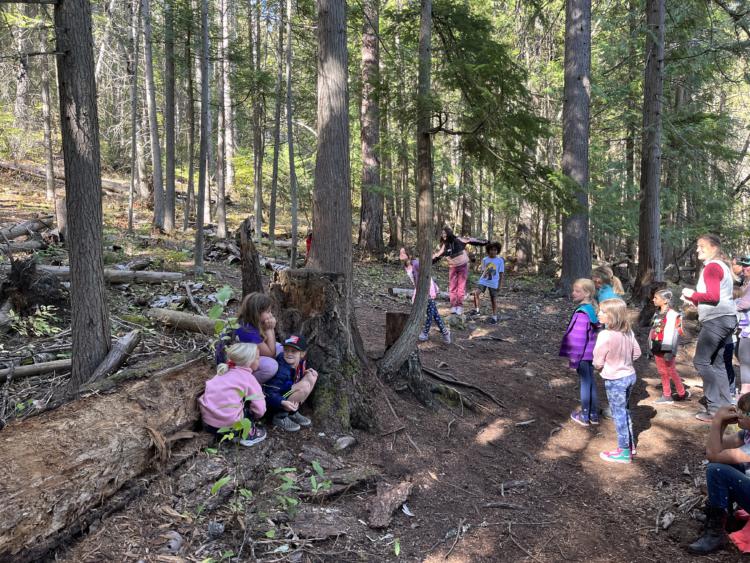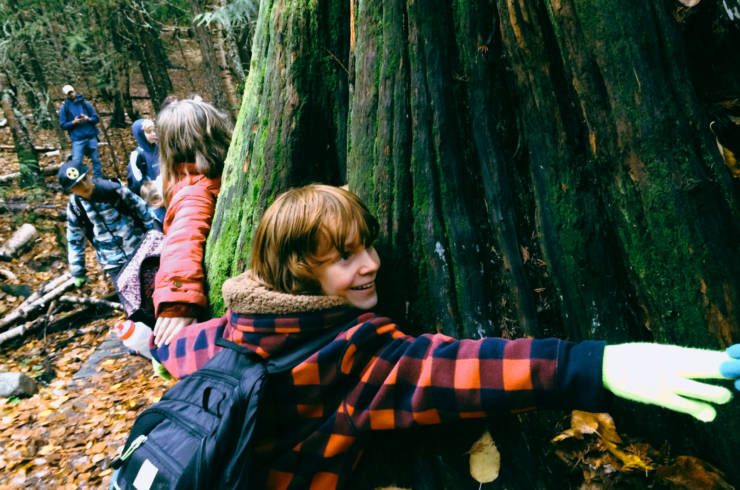“We’re going to visit a grandmother on our walk today,” Wildsight educator Genna Lazier tells students as they head down a winding path on a crisp autumn day. “Keep your eyes out for this very special guest!”
And so the anticipation grows, as the Grade 3/4 class from Nelson’s Hume Elementary School skips and scutters alongside the Kootenay River under a towering forest canopy, searching for Grandmother.
The Slocan Pool trail near Nelson, BC, hugs the valley-bottom, making it an ideal location for today’s environmental education outing. As they walk, Genna tells students about the natural and human history that runs along this river. Pit house depressions show evidence of the Sinixt people, who have lived here since time immemorial. Leftover remnants from the village built to house workers for dam construction can be found here too.
This area holds a unique natural history. Before the damming of the Columbia River, ocean-going salmon would reach these waters. With abundant fish populations, the area would attract a healthy variety of wildlife too, making it an important area for Sinixt to gather.

The children hunt for small critters, look up to the sky through patches of leaves, feel the feathery hemlock tickle their fingers and breathe deep the earthy cool air. At last, they come upon Grandmother: an ancient towering white pine tree, estimated to be 500-600 years old. The students, Genna says, were ecstatic.
“When we got to the tree, the children spontaneously ran up and hugged it,” she recalls. “It was so touching.”
Genna often takes classes on this nature walk, and always builds up to this grandmother tree that ignites the imagination of students, and draws adults to its ancient roots. She teaches the students about the significance of white pine trees like this for the Sinixt people, who use the bark to make sturgeon-nosed canoes.
“I love imagining with the students what that tree has witnessed,” she says. “That tree would have seen the salmon. It knows the Sinixt people. It saw the building of the railways and dams. It has seen so much and connects us all.”
Today’s field trip was through Wildsight’s Classroom with Outdoors program, which brings students from Grades 4-7 on full day field trips to a local grassland, wetland or forest to explore the ecology of their own wild backyards. Students learn about the magic of ecosystems, the complex web of life, links between humans and a healthy environment, and more.

Teacher Janet Mushumanski signed up for Classroom with Outdoors because she sees the value in bringing her students outdoors to learn in and from nature.
“It shows them hands-on the importance of taking care of the Earth,” says Ms. Mushumanski.
This experience was one of 16 Classroom with Outdoors programs that took place across the Columbia Basin this fall, reaching 353 students.
“Classroom with Outdoors gives an opportunity for students to explore their community in ways they may not have already,” shared Kinnaird Elementary teacher Kristen Renz after her class trip. “Having a passionate mentor and allowing kids structured exploration as well as freedom in the outdoors will help create stewards of our environment.”
Research backs up this hope. Studies prove again and again how environmental education leads students to feel connected to the environment around them, and deepens our understanding of both our relationship with each other, and our relationship with nature. In a Stanford University study, researchers analyzed more than 100 studies on environmental education program outcomes with students from K-12. The analysis overwhelmingly supported how environmental education benefits the whole child: going beyond environmental knowledge and extending to higher levels of critical thinking, academic achievement, civic engagement and even personal growth.
One of the study authors, Dr. Nicole Ardoin, had this to say about the research: “There is a mountain of evidence that suggests EE (environmental education) is a powerful way to teach students. Over 100 studies found that it provides transformative learning opportunities that bring tremendous results and engage young people in the world around them in meaningful, collaborative ways. There is no doubt that environmental education is one of the most effective ways to instill a passion for learning among students.”
Genna hopes the students in Ms. Mushumanski’s class left today’s experience with an appreciation for the natural world around them.
“I hope they take away the interconnectedness of us all, from the fish to the trees to the First peoples of this land. I definitely hope they take away a love of the forest,” reflects Genna. “And I hope they remember Grandmother White Pine.”
Thank you to the Columbia Basin Trust, Columbia Power, Copernicus Education Products, Consecon Foundation, Keefer Ecological Services Ltd., Kootenay Co-op, LeRoi Community Foundation, the Osprey Community Foundation, the Province of British Columbia, and all of our individual donors for making this program possible.

Wildsight Education








